CHÂTEAU VIGNELAURE: “THE” RED IN PROVENCE BEFORE TRÉVALLON CAME ALONG…IS BACK!
by Susan Manfull
In 1987, in his introduction to Provence wines in The Wines of the Rhône Valley and Provence, legendary wine critic Robert Parker described the newly created Coteaux d’Aix-en-Provence appellation in four sentences, including: “Two of Provence’s greatest red wines are made here, the Domaine de Trévallon and Château Vignelaure.” Beyond the great red wines to which Parker refers, the history of these two unique estates is intertwined in some very interesting ways.
From their first vintages—1970 at Château Vignelaure and the mid-1970s at Domaine de Trévallon—global recognition for their respective outstanding, age-worthy reds seemed within reach. Separated by about 100 kilometers, the proprietors shared a passion for Cabernet Sauvignon and Syrah that would bring them together and, by all rights, should have launched them on parallel paths to stardom in the wine world. Domaine Trévallon’s ascendancy has been successful—their red wines continue to be revered around the world—but Château Vignelaure’s steady rise to long-term international acclaim faltered.
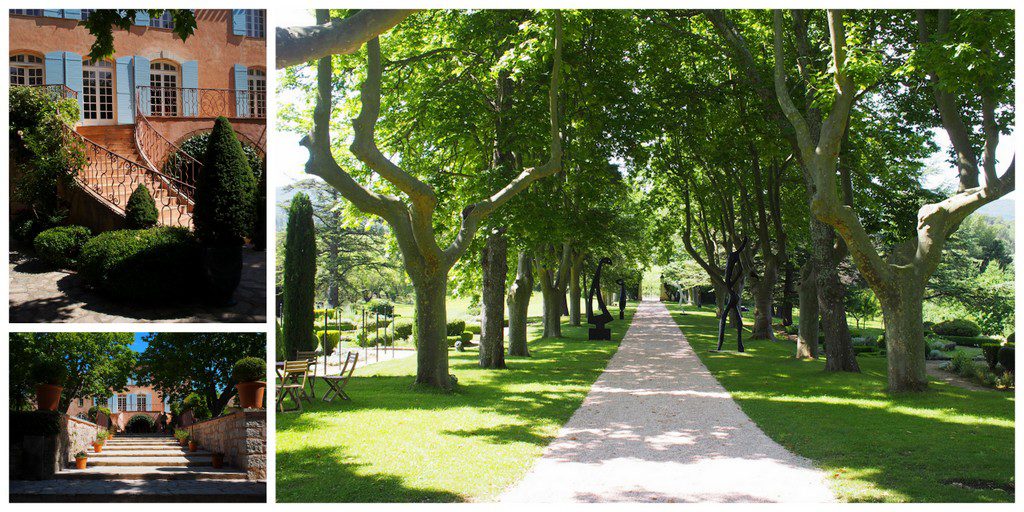
Château Vignelaure. Photo by W.T. Manfull
A recent visit to Château Vignelaure, however, revealed the estate is back on course. In the words of Vignelaure Œoenologue Philippe Bru: “Vignelaure was on top for its reds 30 years ago and now it’s back,” adding with understandable satisfaction, that rosés and whites are now also produced (and receiving accolades).
Château Vignelaure, located in Rians, just north of Aix-en-Provence, comprises about 100 hectares (250 acres), of which 60 are devoted to vines. Sitting nearly 400 meters above sea level in the foothills of Mont Sainte Victoire, these are some of the highest vineyards in the area and generally regarded as too high for some Provençal grape varieties (and not at all suitable for olive trees). The soil is characterized by limestone, clay, and gravel in varying proportions across the property. Its unique micro climate makes viticulture particularly prone to the whims of Mother Nature and requires diligence on the part of the vigneron.
Evidence abounds, including a recently unearthed winery dating back to the 1st century, that the Romans were planting vines and making wines in the area some 2000 years ago, as they seemed to be doing nearly everywhere in Provence at the time. Modern history begins in the mid-1960s when Georges Brunet purchased the rather dilapidated château, named Saint Estèphe at the time, and rechristened it Vignelaure in honor of Italian scholar Petrarch’s muse, Laure. The name change to “Laura’s Vineyard” was just the beginning—Brunet went on to restore the decaying vineyards, replant vines, and elevate the quality of the estate’s production to its pinnacle.
Brunet was a French man, born and raised in Algeria. I don’t know where he acquired his considerable talents in viticulture and viniculture but they were first applied with great success in the Haut-Médoc appellation of the Bordeaux region. There, in 1958, he took on the formidable challenge of completely rebuilding the severely neglected vineyard of Château La Lagune as well as the task of fully reconstructing the cave to make it one of the most sophisticated in the Médoc (for many years, according to Parker). Listed as one of 14 Third Growth Cru Classé Châteaux in the 1855 Bordeaux Wine Classification, the property had many interested buyers—including Alexis Lichine—but none were up to the challenge until Brunet came along.
I don’t know why he opted to leave Bordeaux for Provence before he could realize the benefits of his massive investment in Château La Lagune—the accolades did pour in—but in 1962 he sold it and moved to Provence where he found what would become Château Vignelaure. Bru told us that he changed the name because of its association with Bordeaux, leading me wonder whether we should read anything into that name change in light of his quick departure from that region. Or, perhaps, Brunet simply preferred more sunshine.
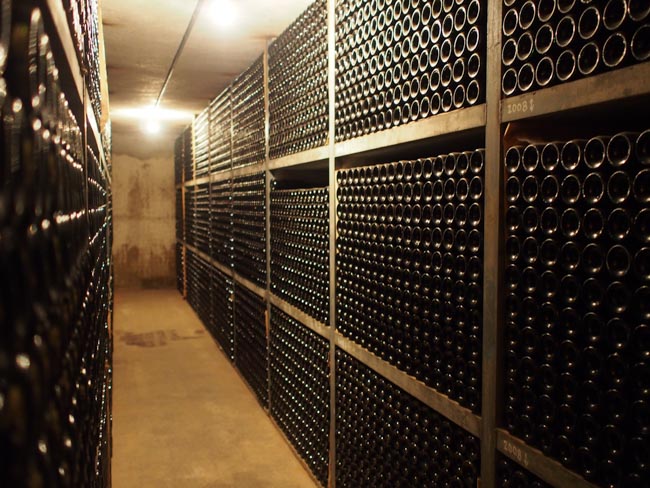
In the cellar of Château Vignelaure, modeled after those in Bordeaux. In Provence, it is very unusual to have the storage to age so much wine. Photo by W.T. Manfull
Brunet did, though, bring a few things with him from Bordeaux: some Cabernet Sauvignon scions, Bordeaux bottles, Bordelaise know-how, and a deep affinity for red wine.
Apparently, Brunet had read the work of Dr. Jules Guyot, a well-known 19th-century agricultural scientist who surveyed the vineyards of France in 1865. Of this area of Provence—before the phylloxera invasion—he wrote that Cabernet Sauvignon blended with Syrah made for an excellent wine.
Brunet replanted 60 hectares of vines, according to Bru, a herculean task that took nearly 10 years. He did not keep any of the original vines. He focused on the traditional local variety, Grenache, as well as Syrah and the very atypical Cabernet Sauvignon (from his Médoc property). It was the first time Cabernet Sauvignon had ever been planted on the property and the first time in a century that it had seen the light of Provence.
The locals thought Brunet was crazy. Even today, Bru estimates that Cabernet Sauvignon probably does not account for more than 5 to 10% of all vines in Provence whereas in Vignelaure it accounts for 35 to 40% of red grapes.
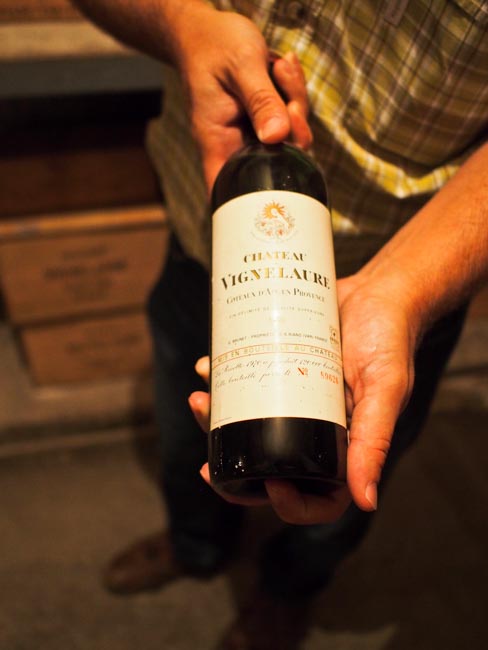
Winemaker Philippe Bru holds a bottle of the first vintage, 1970, of the newly transformed Château Vignelaure. Photo by W.T. Manfull
The first vintage of the newly transformed Château Vignelaure was in 1970. I suspect he filled Bordelaise bottles with his first vintage, the first winemaker to do so in Provence. During the 1970s, the wines (all red until the early 1990s) were exceptionally well-received and Brunet was recognized as an especially innovative winemaker. This must have been a very exciting time to be at Château Vingelaure. It was during this period that Éloi Dürrbach, from the fledgling Trévallon, apprenticed at Château Vignelaure.
In 1973, Dürrbach left his architectural studies in Paris to work with his father René Dürrbach who had purchased Mas Chabert and Trévallon in 1950 and 1955, respectively. Located in Saint Etienne-du-Grès, near Saint-Rémy-de-Provence, the terrain was littered with huge limestone boulders (once part of Les Alpilles) that had to be blasted and carted away, a monumental task taken on by the younger Dürrbach. After preparing land for vines and, upon the recommendation of Brunet, studying the writing of Guyot, the young Dürrbach went to Vignelaure for a couple of years to learn more about making red wine, blending Cabernet Sauvignon and Syrah. Anyone who knows Trévallon, knows he must have been a stellar student who grew into an exceptional innovator, a renegade, and winemaker extraordinaire. His first vintage was in 1976. He continues to make extraordinary wines—both red and white, although I confess I have never had the pleasure of one of his white wines.
In 1995, Les-Baux-de-Provence was separated from Coteaux d’Aix-en-Provence and made its own AOC and with that change, the INAO¹ ruled that Cabernet Sauvignon could not account for more than 20% of the vineyard plantings (the encépagement) and the blend (the assemblage) must consist of a minimum of two grapes, at least one of which must be principal (i.e., Grenache, Mourvèdre, or Syrah) and the proportion of the principal variety or varieties must be 50% or more to be classified as an AOC/AOP wine. (Cabernet Sauvignon is one of the permitted secondary grapes, along with Carignan, Cinsault, or Counoise.) Obviously, with 20 hectares (50 acres) of vines, Dürrbach could not continue making his highly regarded Cabernet Sauvignon-driven red wines and have AOC/AOP status. Rather than compromise the integrity of his wines (by reducing the Cabernet Sauvignon to conform), Dürrbach has opted to make wines that are classified as Vin de Pays or, as they are now referred, Indication Geographique Protégée (IGP) Alpilles.
When we confessed to Bru, that the INAO regulations were practically incomprehensible, he laughed and replied, “They’re very French.”
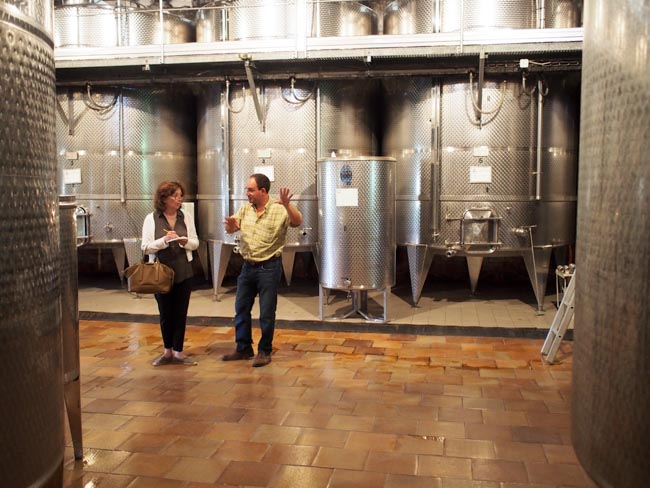
Philippe Bru, Directeur Œnologue, talks to me about winemaking. Photo by W.T. Manfull
At Château Vignelaure, today, Cabernet Sauvignon is permitted in greater quantities under Coteaux d’Aix-en-Provence regulations and Bru takes full advantage of his location by making luscious reds with upwards of 70% of the blend being Cabernet Sauvignon. However, the same mindset as Dürrbach prevails under the tutelage of Bru—if Bru feels that the quality of the wine would be better served without AOC/AOP status, he would not be (automatically) averse to making Vin de Pays wines. Their recently released white wine, the first white wine ever produced at Vignelaure, exemplifies this philosophy—a stellar wine, labeled IGP Méditerranée because it is a blend of Roussanne (70%), which is not permitted in the Coteaux d’Aix-en-Provence appellation, and Rolle (30%). But there I go again, getting ahead of the story.
In 1986, Brunet sold his beloved Château. It would change hands a number of times and the quality of the wine would decline over the next decade or so. According to Rosémary George, author of The Wines of the South of France, it was owned by the chairman of Holiday Inns, the owners of Château de Galoupet in Cotes de Provence, and in 1994, it was purchased by Irishman David O’Brien, a well-known racehorse trainer (and son of world-renowned racehorse trainer Vincent O’Brien). Apparently, he had always wanted to own a winery and, to learn about vineyards and winemaking, according to James May and Oz Clarke, he began working in the vineyard. May and Clarke write that his co-workers were “flabbergasted” when he bought the estate as they had no idea of his means. Bru told us that O’Brien did a lot of work in the vineyard but the quality of wine did not change measurably or consistently for quite a few years.
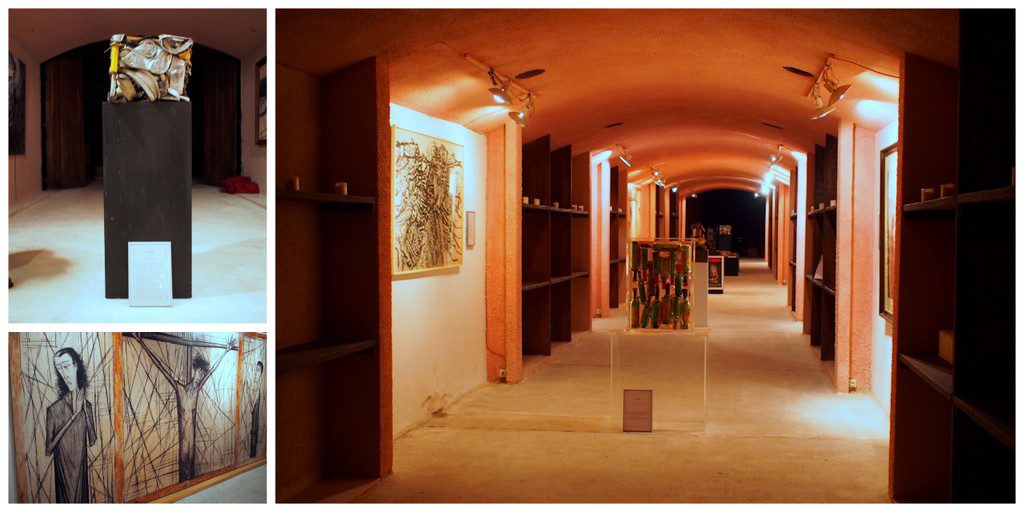
Georges Brunet is credited with renovating Château Vignelaure, replacing its vineyards, reinvigorating its spirit, and establishing a collection of modern art that still adorns a significant part of the cellar. It boasts work by César, Arman, and photographer Cartier Bresson. The current owners, Mett Rede Sundstrøm and Bengt Sundstrøm who are also collectors of art, especially contemporary European art, have continued to add to the original collection. Photo by W.T. Manfull
a Danish-Swedish couple bought Château Vignelaure in 2007. Drawn by the beauty of the estate and its portfolio of wines from the past, coupled with an “enterprising spirit,” they purchased the Château. Although the Sundstrøms lack a background in winemaking, they are said to have the passion to return the estate to its lofty status of the 70s and 80s, the early days of Brunet’s leadership when, according to Bru, “It was the red before Trévallon.”
Based on our vertical tasting of seven vintages of Château Vignelaure reds—2005 to 2010 and a 1988— as well as the three cuvées of rosé (2014), and the singular white wine (2013) added to the portfolio in 2015, I would say that Bru, as Winemaker and General Manager, and his team are very successfully leading the effort toward the pinnacle of quality again.
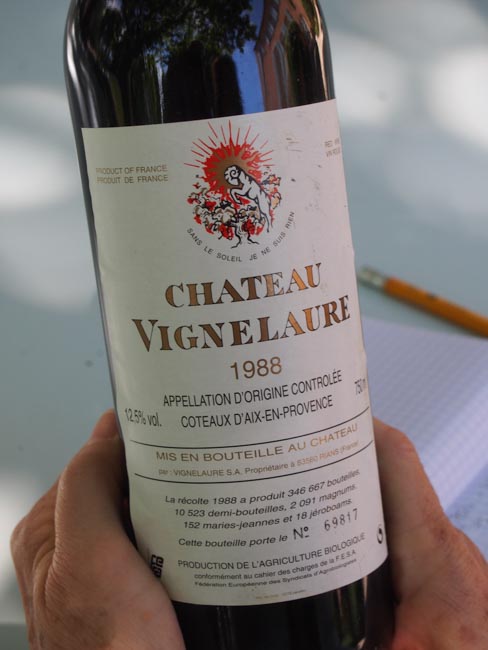
Photo by W.T. Manfull
Our tasting revealed, across the years, a very flavorful bouquet, great structure, lovely balance of ripeness and freshness, very pleasant tannins, elegance, and a seamless flow from nose to finish. Each year, however, has its own personality, with some years, according to my notes, characterized by more or less spice, pine tree resin, garrigue, chocolate, licorice, smoky or vanilla notes. Each wine is immensely enjoyable now but all except the 1988 seem to have the potential to benefit from a few more years in the cellar, especially (unsurprisingly) the ’09 and ’10. The 1988, now 27 years old, was amazing in its freshness, brightness. “Still alive and kicking,” one of us said.
The blends, with two exceptions, were composed of Cabernet Sauvignon (60 or 70%) and Syrah making up the rest of the blend. The 2005 had 5% Grenache and the 1988 has “some” Grenache. The average yield was 20 hl/ha to 26 Hl/Ha. The ABV was 13.5 to 14.5%. Hand harvested, de-stemmed, lightly crushed, parcels and varieties vinified separately, temperature-controlled fermentation in stainless steel, post-fermentation maceration, malolactic fermentation in small oak barrels (one third new), and racked out of barrels after 14 to 18 months. Depending on vintage, the wine was bottled with or without white eggs fining and with no or coarse filtration. The red wines are in the process of converting to organic agriculture and vinification. The average price per bottle is €25 in France.
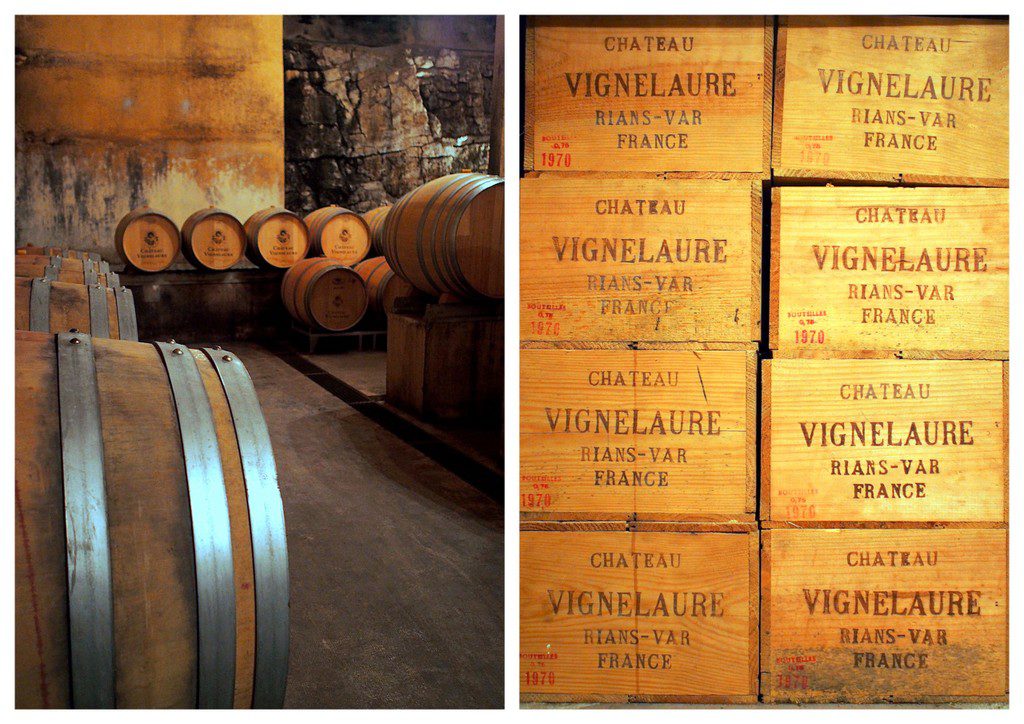
Photo by W.T. Manfull
Red meats come to mind first for good pairings, but I can also envision roasted chicken marrying very nicely with these reds. To read about the 2007 vintage paired with roasted pork tenderloin, see David Scott Allen’s November 2015 Provencal Pairings: Wine with Food column.
I was particularly struck by how light and fresh each of the red wines felt without compromising richness and flavor concentration. We enjoyed these wines on a warm Provençal June morning (not spitting after every taste, I confess) and never did I feel weighed down or lose the desire to taste more. (On the contrary, it would have been easy to have more than a few tipples!) We brought home quite a few of these reds and I can’t wait for at least a few more years to pass.
How do the red wines of Château Vignelaure compare with those of Domaine de Trévallon? I haven’t had a bottle of Trévallon for many years (although there is one in my cellar now), so relying on my notes and those of others, here is my go at it: They are both elegant, well-structured, seamless from nose to finish, age-worthy, and perhaps a little hard to categorize. Given that these wines are crafted to fully express the grapes, the terroir, the climate, and, to some extent, the idiosyncrasies of a winemaker who is keenly attuned to the nuances that define each cépage, it is not surprising that each vintage has a distinctive personality. Clearly related to earlier vintages though each is distinctive (something my daughter might underscore about my mother and me). “Fresh” and “lively” come to mind first when I think of Vignelaure whereas “concentrated” and “bold” surface when I think of Trévallon. Trévallon reds run about €10 more a bottle than Vignelaure.
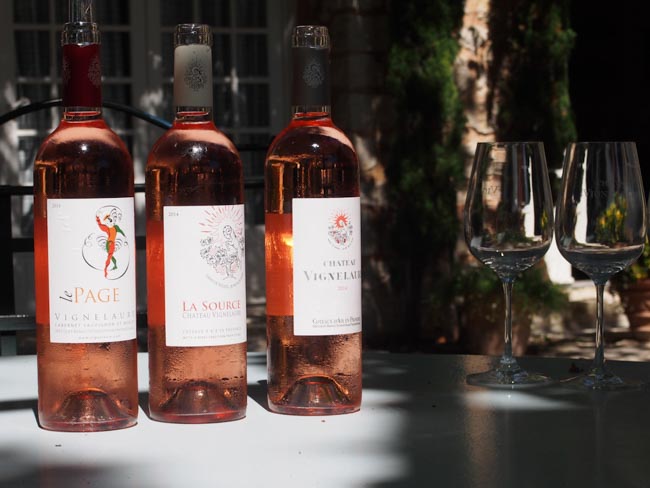
Photo by W.T. Manfull
Aside from the Château Vignelaure red cuvée, two other reds are produced at the estate—La Source and Le Page—neither of which we tried.
The Château also produces three cuvées of rosé, representing each of the aforementioned lines. We sampled all three. Slightly darker in color than the pale rosés typically seen in Provence—owing to Cabernet Sauvignon and, in Le Page, Merlot—each of these rosés is characterized by elegance, freshness, and good acidity. I was slightly partial to La Source, with its hints of saltiness and nice finesse. All would marry well with food. Château Vignelaure and La Source rosés are both now available in the States.
The Château Vignelaure Blanc (2013), a blend of Roussane (70%) and Rolle (30%), is the first white wine ever produced on the property and was just released before our visit in June 2015. What good fortune for us! Attributing much of the success of the wine to top terroir, Bru said that as the Roussane vines age—they were just six years old when they produced the grapes for this wine—the wine will continue to grow in complexity. “There’s huge potential for the whites,” Bru said. I can’t wait to try more!
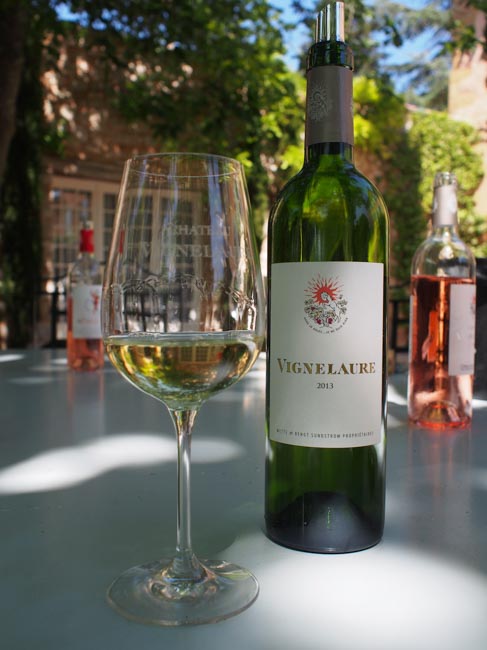
Photo by W.T. Manfull
The fragrant nose of this white is remarkably alluring, the palate is creamy (owing perhaps to half of the wine fermenting in 400-liter oak barrels) with layers and layers of incredible flavors. Green apple and kiwi permeate this well-balanced white that boasts perfect acidity and Old World elegance. A long finish that begs for more. Truly, one of the best white wines that has crossed my palate in a long time. Organic. 13.5% ABV. Retails in France for about €21.
“There’s huge potential in the top terroir to make top reds and whites,” Bru told us. Indeed.
After at least a decade of unremarkable vintages, “it’s back,” as Bru told us, this time around sporting an impressive tri-color portfolio. Red wine now comprises 50% of production at Château Vignelaure, rosé 40%, and white 10% whereas across Provence, rosé wine makes up about 88% of AOP production.
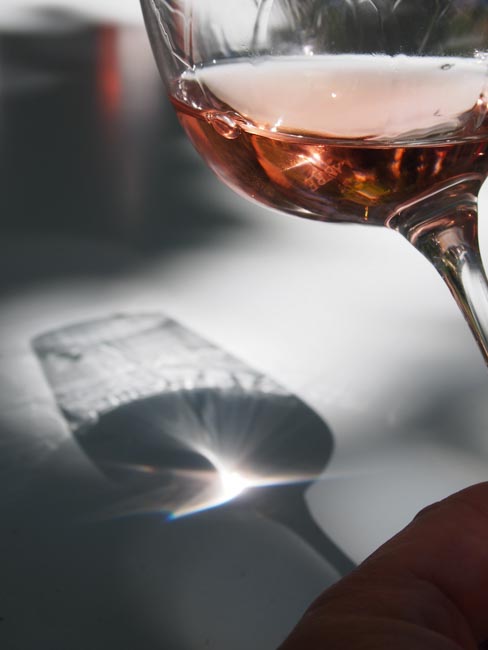
Photo by W. T. Manfull
With the immensely successful campaign promoting Provence rosé, leading to the now familiar statistics revealing explosive growth around the globe, some wine writers have wondered whether there is room for exceptional reds and whites from Provence?
In the U.S., from January 2015 to January 2016, Provence rosé imports have grown 58% on volume and 74% on value, not including on-premise bars and restaurants (which comprise 20% of the market) or small independent retailers—all to say growth figures may be much higher. Will consumers take a chance on reds and whites—however outstanding they may be—from a region that has perfected rosé? Is there enough red and white volume to attract importers?
Bru feels that education—Provence is not just rosé—is essential, from the consumer to the sommelier level. Increased production of reds and whites is imperative if importers are to be attracted—so little white wine is currently produced in Provence that most of it is consumed locally—but that would take a long time and with pink wine selling so easily, what would the motivation be? These are complicated issues that winemakers like Bru are currently grappling with.
Domaine Trévallon’s striking success—even with no rosé in the portfolio, Dürrbach seems proud to boast—would suggest there is a way. And, if any estate can follow in Trévallon’s footsteps, it is Vignelaure. Let’s not forget where Dürrbach began his métier de vin.
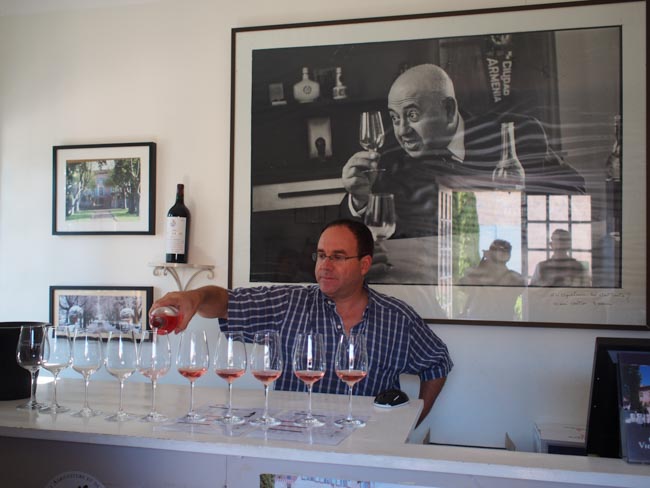
Philippe Bru, Directeur Œnologue at Château Vignelaure, lines up the glasses for a tasting The Modern Trobadors Tour Group. Photo by W.T. Manfull
Notes:
Château Vignelaure
Route de Jouques
83560 Rians
Tel: +33 (0)4 94 37 21 10
Fax: +33 (0)4 94 80 53 39
Email: info@vignelaure.com
www.vignelaure.com
¹INAO is the official government body, part of the Ministry of Agriculture, tasked with overseeing French agricultural products with Protected Designations of Origin (PDOs), referring to, in this case wine. It stands for “Institut national des appellations d’origine,” although the name has changed to “Institut national de l’origine et de la qualité” but still identified by its original initials.

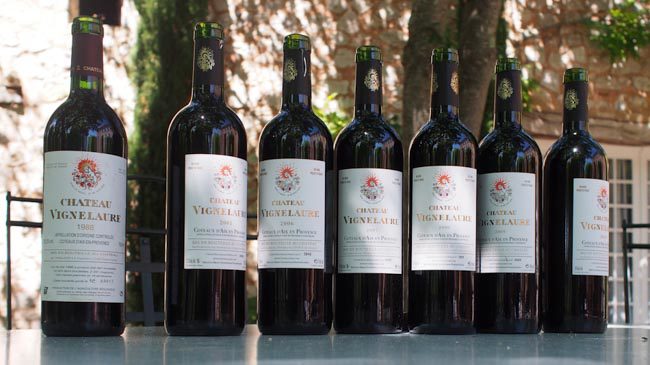
Great story Susan!
Thanks, Joanne! There’s a lot of the story I left out…will fill in the pieces over a glass of wine sometime soon!
I really enjoyed this story. If only you could send me some wine electronically, the experience would be complete.
Maybe not electronically…but, soon, I could arrange for a drone to drop it off! Thanks for popping by, Lisa, with such nice feedback!
Beautiful job, Susan. Your tasting notes propel me to jump in my car and head to Château Vignelaure with great haste. In response to your comments on Provence reds and whites, I cannot see how the growing popularity of the rosés can do anything but enhance awareness and broaden the target market for all of the region’s wines as well as bring a greater number of individual domains to the attention of buyers. Prior to the “rosé revolution” there were very few Provence vineyards known outside of Provence. I also imagine that the new found capital from rosé sales is a godsend for many vineyards and bodes well for augmenting both quality and quantity of red and white wine production in the future.
I agree with your thoughts about the “other colors” benefiting from the outstanding marketing of “Provence Rosé.” Some folks are concerned, with reason, that vines previously dedicated to red and white wines may be yanked out in favor of those for rosé. Bru’s sentiments about “education” are echoed by others, too, and that without it, reds and whites can’t make the jump. There was certainly a lot of education that contributed to the pink revolution! Lots to talk about! Thanks for sharing your thoughts!
Love this! And thanks for the link back to the pairing I did with the roasted pork! It would be fun to taste some of their other wines!
That roasted pork is so exquisite…I love your recipe for that! Now, I must try it with Vignelaure! Will you be in the neighborhood anytime soon?!
I did not know history of this property and efforts of George Brunet to instill Cabernet Sauvignon in Provence. It seems he had significant influence on the better known Durrbach. The logo at top of Vignelaure label to me is a riff on Philippe Rothschild of Ch. Mouton Rothschild, who effectively used the symbol of the ram at his estate. Perhaps it was Brunet’s homage to Rothschild, who in his lengthy efforts to re-classify his second growth status inscribed on each label “Premier ne puis, second ne daigne, Mouton suis.” Whatever Brunet’s motivation, I like the logo.